Diseases like bacterial spot can threaten tomatoes, a $1.9 billion-a-year crop planted on 330,000 acres across 18 states.

Gary Vallad, a University of Florida Institute of Food and Agricultural Sciences (UF/IFAS) professor of plant pathology, has been awarded a $5.8 million federal grant to study how to mitigate this disease.
“Bacterial spot of tomato is a major challenge to commercial production throughout the United States and threatens long-term sustainability of tomatoes, because we lack sufficient control measures,” said Vallad.
Vallad, a faculty member at the Gulf Coast Research and Education Center, is principal investigator for the grant, funded by the U.S. Department of Agriculture National Institute of Food and Agriculture.
He will lead a team of five other UF/IFAS faculty for the Florida portion of the research. Nineteen scientists across the country will augment the UF/IFAS research by also studying ways to better control bacterial spot.
The problem lies less with farmers and more in how bacterial spot is managed along the production chain – from seed to field production, Vallad said. The technology is there: Next-generation sequencing coupled with improved disease detection methods so the research team can follow the bacterium that causes the disease throughout the production cycle. It could lead to new sources of disease resistance to improve tomato varieties for farmers.
Vallad and his colleagues will sample strains of bacterial spot from commercial transplant facilities that produce tomato seedlings for farming. He hopes to reduce economic losses throughout the fresh-market and processing tomato industries. His goals include:
- Work with breeders to develop varieties with increased resistance to bacterial spot.
- Produce effective and safe bactericidal materials to limit bacterial spread and the development of resistant bacterial strains.
- Develop strategies to help prevent disease outbreaks.
- Improve capacity to identify and track new strains of the disease.
Results of the research may prevent needless applications of copper-based chemicals to help control bacterial spot, which helps address environmental concerns over the accumulation of copper in soils. It also can save money for growers.
“Giving farmers the tools and resources to tackle diseases like bacterial spot helps minimize their reliance on chemicals, thereby reducing unwanted impacts to the environment, while providing consumers a better U.S.-grown tomato,” Vallad said.










